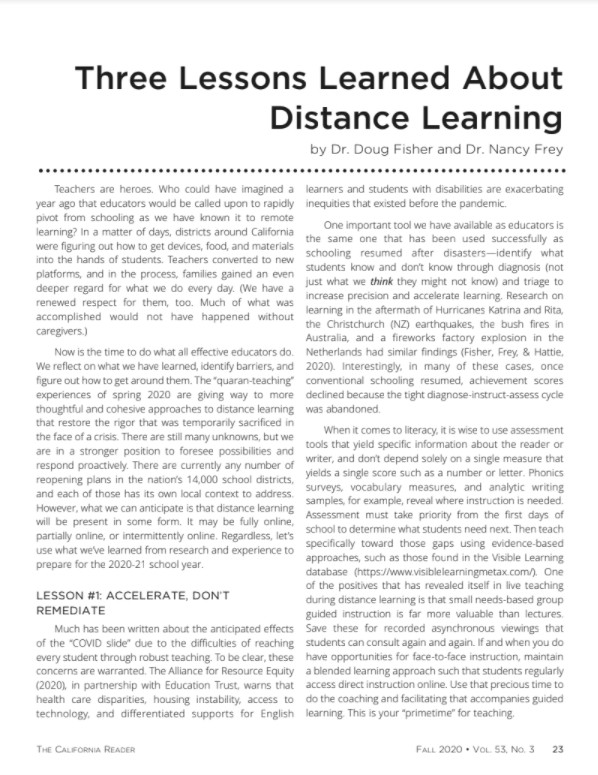Teachers are heroes. Who could have imagined a year ago that educators would be called upon to rapidly pivot from schooling as we have known it to remote learning? In a matter of days, districts around California were figuring out how to get devices, food, and materials into the hands of students. Teachers converted to new platforms, and in the process, families gained an even deeper regard for what we do every day. (We have a renewed respect for them, too. Much of what was accomplished would not have happened without caregivers.)
Now is the time to do what all effective educators do. We reflect on what we have learned, identify barriers, and figure out how to get around them. The “quaran-teaching” experiences of spring 2020 are giving way to more thoughtful and cohesive approaches to distance learning that restore the rigor that was temporarily sacrificed in the face of a crisis. There are still many unknowns, but we are in a stronger position to foresee possibilities and respond proactively. There are currently any number of reopening plans in the nation’s 14,000 school districts, and each of those has its own local context to address. However, what we can anticipate is that distance learning will be present in some form. It may be fully online, partially online, or intermittently online. Regardless, let’s use what we’ve learned from research and experience to prepare for the 2020-21 school year.
LESSON #1: ACCELERATE, DON’T REMEDIATE
Much has been written about the anticipated effects of the “COVID slide” due to the difficulties of reaching every student through robust teaching. To be clear, these concerns are warranted. The Alliance for Resource Equity (2020), in partnership with Education Trust, warns that health care disparities, housing instability, access to technology, and differentiated supports for English learners and students with disabilities are exacerbating inequities that existed before the pandemic.
One important tool we have available as educators is the same one that has been used successfully as schooling resumed after disasters—identify what students know and don’t know through diagnosis (not just what we think they might not know) and triage to increase precision and accelerate learning. Research on learning in the aftermath of Hurricanes Katrina and Rita, the Christchurch (NZ) earthquakes, the bush fires in Australia, and a fireworks factory explosion in the Netherlands had similar findings (Fisher, Frey, & Hattie, 2020). Interestingly, in many of these cases, once conventional schooling resumed, achievement scores declined because the tight diagnose-instruct-assess cycle was abandoned.
When it comes to literacy, it is wise to use assessment tools that yield specific information about the reader or writer, and don’t depend solely on a single measure that yields a single score such as a number or letter. Phonics surveys, vocabulary measures, and analytic writing samples, for example, reveal where instruction is needed. Assessment must take priority from the first days of school to determine what students need next. Then teach specifically toward those gaps using evidence-based approaches, such as those found in the Visible Learning database. One of the positives that has revealed itself in live teaching during distance learning is that small needs-based group guided instruction is far more valuable than lectures. Save these for recorded asynchronous viewings that students can consult again and again. If and when you do have opportunities for face-to-face instruction, maintain a blended learning approach such that students regularly access direct instruction online. Use that precious time to do the coaching and facilitating that accompanies guided learning. This is your “primetime” for teaching.
LESSON #2: SPOTLIGHT READING VOLUME
Another very real concern is that students’ reading volume has declined in the past few months. Students strengthen their reading ability by having eyes on print. Allington’s (2002) work with exemplary elementary teachers found that their students significantly more time reading. Notice that we did not say reading instruction. In contrast, typical classes had only 20 minutes across the entire school day actually reading. Students need about 90 cumulative minutes across the school day engaged in reading. Without the structure of schooling, it is likely that many children have not maintained a high volume of reading.
Going forward, a robust distance learning plan should include reading every day. These can be readings that students need to complete in advance of live virtual instruction, as well as passages they read during instruction. Our work on reading volume has shown us that an ABCD model works well (Fisher & Frey, 2018):
- Access: Increase access through digital readings;
- Book talks: Use book talks to profile several books each day to your students;
- Choice: Provide choice through thematic text sets so that students can select readings; and
- Discussion: Create discussion opportunities such as book clubs and literature circles.
Knowledge is critical for reading comprehension, writing, and academic achievement. Students who read more know more about the physical, biological, and social world. These four practices belong in the distance learning plans of every literacy teacher. Without attention to reading volume, we put an increasing number of students at risk of not profiting from their education.
LESSON #3: INFUSE SOCIAL AND EMOTIONAL LEARNING
The sudden physical separation from our students highlighted, more than ever, how important SEL is in schooling. As we enter a new school year, the texts we select will be crucial for bridging the divide that has traditionally existed between SEL and academic learning. Choose informational and narrative texts that highlight SEL themes and use them to discuss how real and imagined characters address the dilemmas they face. A Bike Like Sergio’s (Boelts, 2016) highlights the tensions of economic hardship and ethical responsibility for first graders. Sit (Ellis, 2018) is a chapter book for middle grade readers about nine acts of social justice performed by children around the world. Stamped: Racism, Anti-Racism, and You (Reynolds & Kendi, 2019) is informational text for secondary readers about material ways to take action and learn about historical and structural racism. These are only three examples of the many texts that elevate discussion and writing about topics that energize and empower children.
Link social and emotional learning topics to actions. Students can write to politicians and leaders about social injustice. They can engage in home projects that benefit their families, such as starting a home garden or setting up a home recycling area. Younger children can work to identify their emotions during daily emotional check-ins that you host during each live session (face-to-face and virtual). They can practice cognitive self-regulation by setting goals each week and measuring their progress toward them. However, none of these things are likely to take place if we don’t plan for them with intention. In the same way that we regularly consult the academic standards, we must also utilize the SEL principles taught through the school and ensure that they are visible, present, and applied in each lesson.
CONCLUSION
As educators we are currently occupying a space of uncertainty. One thing that we can count on is that the 2020-21 school year will be unlike any other we have experienced. But we didn’t forget how to teach, even as we are challenged by new platforms. Circle back to the things you know. Diagnostic teaching accelerates learning because it increases our precision. The value of reading volume is greater than ever and is influenced by what we do and do not do. And social and emotional learning infused into the academic lifeblood of the class amplifies learning. By using what we know and reflecting on what we have learned we can regain our footing for ourselves and our students.
REFERENCES
Alliance for Resource Equity. (2020). Education resource equity in 2020-21: An action guide for district leadership.
Allington, R. (2002). What I’ve learned about effective reading instruction from a decade of studying exemplary elementary classroom teachers. Phi Delta Kappan, 83(10), 740-747.
Fisher, D., & Frey, N. (2018). Raise reading volume through access, choice, discussion, and book talks. The Reading Teacher, 72(1), 89–97.
Fisher, D., Frey, N., & Hattie, J. (2020). The Distance Learning Playbook, Grades K-12: Teaching for Engagement and Impact in Any Setting. Corwin.







